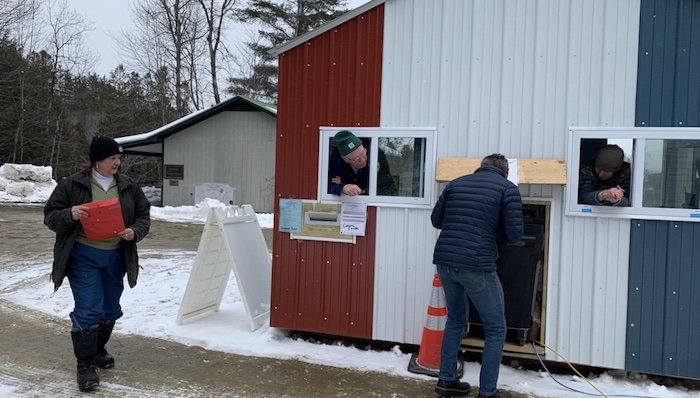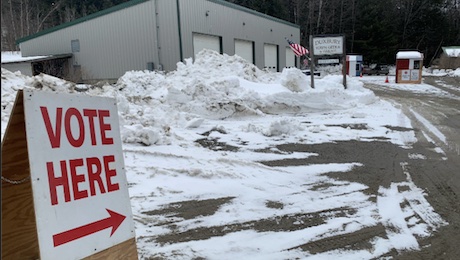
Duxbury Town Clerk Maureen Harvey (left) and election workers Mark Morse (left window) and Shawnee Perry (right window) watch as a voter puts a ballot into the tabulator inset into the new checkout booth at the Town Meeting Day drive-through (and walk-up) polling setup outside the town offices.
By Cora Smith and Lisa Scagliotti | Community News Service
With a second drive-up voting booth set up outside the town garage and town office, Duxbury voters cast their ballots from their vehicles on Town Meeting Day with all items passing handily.
Turnout of 269 voters on Tuesday worked out to 23% of the town’s checklist, the greatest percentage turnout of all of the six towns in the Harwood Unified Union School District.
The proposed town budget was presented in three articles to voters. Voters approved spending $1,086,960 for general government and the town highway budgets, 223-34. A request to put $113,000 into the capital reserve passed 219-38 and voters agreed to put $30,000 into a pavement escrow account, 207-43, according to results from Town Clerk Maureen Harvey.
None of the elections for town or school board officials were contested.
Getting 217 votes, selectboard member Jamison Ervin was elected to a three-year term after serving one year. Ann Harvey was on the ballot for a one-year selectboard seat and received 220 votes; Patrick Zachary won the other one-year term with 77 write-in votes.
Other offices filled include Alan Quackenbush as lister; Daniel Senning as moderator; Jessica Engles, Elliott McElroy and Dwight Day for Cemetery Commission.
Harvey was elected as delinquent tax collector and Nathan Isham as first constable.
Voters also approved changing the term lengths for first and second constable from one year to two years and for delinquent tax collector from one to three years, all starting in 2024.
Harwood Unified Union School Board members Cindy Senning and Life LeGeros were unopposed for a three-year and two-year term respectively.

Drive-through voting becomes the main activity outside the Duxbury Town Office and Garage on Town Meeting Day.
This year’s Town Meeting Day election was conducted entirely by Australian ballot after Duxbury voters in November held a special town meeting to end their in-person Town Meeting format starting in 2023. Drive-through voting has caught on since summer 2020 when the new format was put in place during the COVID-19 pandemic. Town officials and voters have expressed their preference for the new method which has been met with increased voter turnout.
In lobbying last fall to make Australian ballot voting permanent, Harvey stressed how 350 residents came out to vote on Town Meeting Day in 2022, up from 2020 when only about 120 residents voted at the in-person town meeting.
Evolving drive-through setup
Since the June 2020 Harwood school budget revote, town election officials have set up a loop – first at Crossett Brook Middle School and later at the town garage and offices – where voters drive up to receive a ballot, pull off to the side to mark it, then proceed to a check-out area before exiting.
As the process was refined, Duxbury resident Mo LaVanway built a small booth for the check-in spot. Decked out with red, white and blue metal roofing as siding, the 6×6-foot shed resembles a well-decorated ice fishing shanty.
Ahead of this week’s election, Lavanway went to work on a second check-out booth to replace the pop-up tent election workers used in the November general election. The open-air tent was cold and dark. On Tuesday, the spacious new booth – measuring 8×12 feet – was put to the test.
It easily fit four people inside. It had chairs, a small counter, and two sliding windows on the side where voters drive up. In the center is an opening that fits a tabulator machine that sits inside but is accessible from outside so voters can feed their ballots themselves. That was included based on feedback from voters.
“They wanted that instant connection with the tabulator,” Town Clerk Maureen Harvey said.
A slot under one window worked for school ballots, with them dropping into a bin on the inside. Some insulation fitted around the tabulator kept out drafts. A space heater made the inside space comfortable thanks to more insulation behind the moisture-resistant drywall interior finish that LaVanway used. (Power cords run to the nearby town garage building.)
Justices of the Peace Mark Morse and Shawnee Perry worked together greeting voters and directing them as they turned in their ballots.
“Just like Dunkin Donuts,” Morse quipped as he leaned out the window to talk with voters.
Once Perry checked voters off after their ballots were turned in, she reached into a jar of Hershey kisses to hand them a treat. “We don’t have ‘I Voted’ stickers,” she said, explaining the more-than-adequate substitution.
During a break in the traffic, Perry took in the new set-up and said it’s evolved to a pretty smooth system. And while it may not be something every town wants to adopt, those considering drive-through voting shouldn’t be daunted. “We can tell other towns this is possible,” Perry said.
LaVanway said the cost of making the booths was approximately $2,500 for the small one and $6,800 for the larger one. It appears from the town report that American Rescue Plan Act funds helped to pay for them.
Over at the check-in booth, Justice of the Peace Greg Trulson greeted voters and handed them ballots on clipboards with black felt-tip markers clipped that the top. He ticked off the steps: “No drama here. I hand out ballots. I hand out candy. I hand out dog treats. And everyone’s excited.”
New Duxbury resident Arielle Edelman made her way through the loop in her green Subaru including stopping to go inside the town office to register to vote. Recently having moved from Maine, she said Town Meeting Day was her first election in her new hometown. “I’ve never voted in Vermont before. And I’ve never voted like this,” she said. “It was really efficient.”
Once she rejoined the line to get, fill out, and turn in her ballots, she declared it a success and counted several chocolates she didn’t have when she arrived.
Veteran voter Ames Robb, who has lived in town for almost 20 years and voted in every annual meeting, said the drive-through method is set up well. She said the new method is quicker and convenient.
Not everyone is convinced. Among those who paused to talk with a reporter, many reminisced about the “meeting” part of Town Meeting Day where, until 2020, all decisions – even elections – were decided at the in-person meetings by those who attended.
Father and son Clinton Bedell Sr. and Clinton Bedell Jr. said they prefer meeting in person. Both have lived in Duxbury since 1972, and Bedell Jr. attended Harwood Union High School.
Bedell Sr. said the meetings allow for more socializing. He said he liked being able to meet neighbors he wouldn’t normally see. The younger Bedell said that a town meeting makes it easier to bring up concerns. He said he dislikes the Australian ballot because it makes it harder to vote for those who can’t read.
Justice of the Peace Jill Smith admitted that she misses gathering with her community on Town Meeting Day. She recalled how residents could have a disagreement during a meeting and then solve it over dinner. Smith said she wishes there was more dialogue like that.
When townspeople in November met to vote on changing the format for future Town Meetings, Smith advocated for a community gathering to be held in January before the Selectboard set the budget so voters could ask questions and offer input. On Jan. 7 Duxbury hosted a “Citizens Have Your Say Day” where, among other things, residents discussed the budget and town finances with the board. No changes were recommended to the budget draft and no voting occurred.
Town clerk since 2016, Harvey pointed out that a little more than 100 people attended that January meeting – about the same turnout as a typical in-person March Town Meeting in the past.
While voting methods may be debated for years to come, those voting agreed that the business at hand on Town Meeting Day is consequential, both for the town and for local schools. The big-ticket item on Tuesday’s ballot: the $45 million Harwood Unified Union School District budget.
Pam Chrisholm, a Duxbury resident since 1984, said she’s probably missed only two or three elections in 40 years and that voting for schools is always a high priority for her. She said she used to take her son to vote, and he would get upset that he was too young to cast a ballot.
Ames Robb echoed Chrisholm’s sentiment about valuing schools. The dollar amount per pupil though “makes my eyes pop,” Robb remarked. Yet, she added that she still supported the proposed budget.
The Community News Service is part of the Reporting and Documentary Storytelling Program at the University of Vermont.


